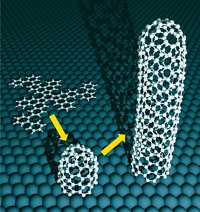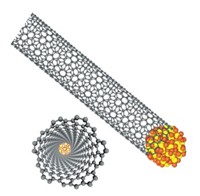Advertisement
Grab your lab coat. Let's get started
Welcome!
Welcome!
Create an account below to get 6 C&EN articles per month, receive newsletters and more - all free.
It seems this is your first time logging in online. Please enter the following information to continue.
As an ACS member you automatically get access to this site. All we need is few more details to create your reading experience.
Not you? Sign in with a different account.
Not you? Sign in with a different account.
ERROR 1
ERROR 1
ERROR 2
ERROR 2
ERROR 2
ERROR 2
ERROR 2
Password and Confirm password must match.
If you have an ACS member number, please enter it here so we can link this account to your membership. (optional)
ERROR 2
ACS values your privacy. By submitting your information, you are gaining access to C&EN and subscribing to our weekly newsletter. We use the information you provide to make your reading experience better, and we will never sell your data to third party members.
Materials
Nanohoops Scaled Up 100-fold
Organic Chemistry: Grams of benzene-based rings could aid synthesis of conductive nanowires
by Stu Borman
July 19, 2012
| A version of this story appeared in
Volume 90, Issue 30
![This figure shows structures of [8]CPP and [10]CPP. The [8]CPP rings can link to make an armchair carbon nanotube, also shown. This figure shows structures of [8]CPP and [10]CPP. The [8]CPP rings can link to make an armchair carbon nanotube, also shown.](https://s7d1.scene7.com/is/image/CENODS/09030-notw8-Jastigram?$responsive$&wid=300&qlt=90,0&resMode=sharp2)
Preparation of carbon nanotubes as pure substances could benefit from a new way to make gram amounts of “nanohoops” (Chem. Sci., DOI: 10.1039/c2sc20719b). Nanohoops—or cycloparaphenylenes (CPPs)—are like bracelets made from para-linked benzene rings. Stacking of CPPs could be the basis for preparing useful quantities of pure carbon nanotubes.
The work has implications for nanoelectronics because armchair nanotubes, the type of carbon nanotubes that would be made by nanohoop stacking, are highly prized as conductive nanowires.
Carbon nanotubes are now made by techniques such as graphite vaporization, chemical vapor deposition, and electric arc discharge. These random processes form variable-diameter mixtures of armchair and two other types of carbon nanotubes. Because the electrical conducting properties of the three types are completely different, it has been difficult to study and develop carbon nanotubes for nanoelectronics applications.
Synthetic organic chemist Ramesh Jasti—then in Carolyn R. Bertozzi’s group at Lawrence Berkeley National Laboratory’s Molecular Foundry—and coworkers first synthesized CPPs catalytically in 2008 (C&EN, Dec. 22, 2008, page 9; J. Am. Chem. Soc., DOI: 10.1021/ja807126u). But the catalysts they used weren’t ideal, and yields of CPPs were low. CPPs have remained so difficult to make that they are currently sold commercially for about $100 per milligram.
Jianlong Xia and Jeffrey W. Bacon in Jasti’s group, now at Boston University, have developed a new catalytic method that boosts the yields of eight- and 10-unit nanohoops by two orders of magnitude.
Shigeru Yamago of Japan’s Kyoto University, whose group specializes in CPP synthesis, comments that fullerene applications didn’t develop until a way was found to synthesize C60 on a large scale and that CPPs are even more electronically tunable than C60. “The large-scale synthesis of CPPs,” he says, “could have a significant impact on materials science and the use of conducting organic molecules.”
Kenichiro Itami of Japan’s Nagoya University, another CPP synthesis expert, says the Jasti group’s synthesis “will surely allow others to make and use CPPs on a daily basis and also will help reduce the price of CPPs significantly. This is the method many researchers have been waiting for.”
Carbon nanotube researcher Lawrence T. Scott of Boston College adds that the gram-scale synthesis “potentially opens the door to new ways of growing grams” of carbon nanotubes. Nobody has yet synthesized carbon nanotubes rationally, from the ground up, starting with a small hydrocarbon template, he says. “But many of us are trying to learn how to do that, and the new synthesis is a step forward in that direction.”




Join the conversation
Contact the reporter
Submit a Letter to the Editor for publication
Engage with us on Twitter